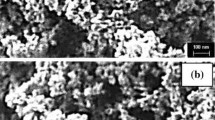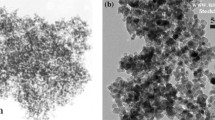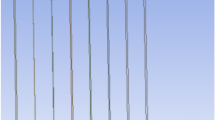Abstract
The present study deals with the entropy generation analysis of a flat-plate solar collector using SiO2/ethylene glycol–water nanofluids. For this purpose, available experimental data on the performance of a flat-plate solar collector are exploited for estimating the entropy generation in the system. Ethylene glycol–water (EG–water) and EG–water-based nanofluids having three different nanoparticle volume fractions including 0.5, 0.75, and 1 % are considered as the working fluids. The results are presented in terms of exergy efficiency, entropy generation parameter, and Bejan number for three different mass flow rates and various solar radiation intensities. It is found that when nanofluid concentration increases from 0 to 1 %, exergy efficiency enhances up to 62.7 % for a mass flow rate of 1 L min−1, whereas the corresponding increases in mass flow rates of 1.75 and 2.5 L min−1 are 45.2 and 39.7 %, respectively. The results also elucidate that entropy generation parameter, which is a function of entropy generation, ambient temperature, and solar radiation, reduces with increasing the nanofluid concentration.








Similar content being viewed by others
References
Esfe MH, Saedodin S. Turbulent forced convection heat transfer and thermophysical properties of Mgo–water nanofluid with consideration of different nanoparticles diameter, an empirical study. J Therm Anal Calorim. 2015;119(2):1205–13.
Ahammed N, Asirvatham LG, Wongwises S. Effect of volume concentration and temperature on viscosity and surface tension of graphene–water nanofluid for heat transfer applications. J Therm Anal Calorim. 2016;123(2):1399–409.
Esfe MH, Saedodin S, Bahiraei M, Toghraie D, Mahian O, Wongwises S. Thermal conductivity modeling of MgO/EG nanofluids using experimental data and artificial neural network. J Therm Anal Calorim. 2014;118(1):287–94.
Bashirnezhad K, Rashidi MM, Yang Z, Bazri S, Yan WM. A comprehensive review of last experimental studies on thermal conductivity of nanofluids. J Therm Anal Calorim. 2015;122(2):863–84.
Esfe MH, Saedodin S, Wongwises S, Toghraie D. An experimental study on the effect of diameter on thermal conductivity and dynamic viscosity of Fe/water nanofluids. J Therm Anal Calorim. 2015;119(3):1817–24.
Abbasi S, Zebarjad SM, Baghban SHN, Youssefi A, Ekrami-Kakhki MS. Experimental investigation of the rheological behavior and viscosity of decorated multi-walled carbon nanotubes with TiO2 nanoparticles/water nanofluids. J Therm Anal Calorim. 2016;123(1):81–9.
Esfe MH, Saedodin S, Yan WM, Afrand M, Sina N. Study on thermal conductivity of water-based nanofluids with hybrid suspensions of CNTs/Al2O3 nanoparticles. J Therm Anal Calorim. 2016;124(1):455–60.
Esfe MH, Saedodin S, Mahian O, Wongwises S. Thermal conductivity of Al2O3/water nanofluids, measurement, correlation, sensitivity analysis, and comparisons with literature reports. J Therm Anal Calorim. 2014;117(2):675–81.
Bigdeli MB, Fasano M, Cardellini A, Chiavazzo E, Asinari P. A review on the heat and mass transfer phenomena in nanofluid coolants with special focus on automotive applications. Renew Sustain Energy Rev. 2016;60:1615–33.
Nitiapiruk P, Mahian O, Dalkilic AS, Wongwises S. Performance characteristics of a microchannel heat sink using TiO2/water nanofluid and different thermophysical models. Int Commun Heat Mass Transf. 2013;47:98–104.
Halelfadl S, Estellé P, Maré T. Heat transfer properties of aqueous carbon nanotubes nanofluids in coaxial heat exchanger under laminar regime. Exp Thermal Fluid Sci. 2014;55:174–80.
Maré T, Halelfadl S, Sow O, Estellé P, Duret S, Bazantay F. Comparison of the thermal performances of two nanofluids at low temperature in a plate heat exchanger. Exp Thermal Fluid Sci. 2011;35:1535–43.
Esfe MH, Saedodin S, Mahian O, Wongwises S. Heat transfer characteristics and pressure drop of COOH-functionalized DWCNTs/water nanofluid in turbulent flow at low concentrations. Int J Heat Mass Transf. 2014;73:186–94.
Esfe MH, Saedodin S, Mahian O, Wongwises S. Thermophysical properties, heat transfer and pressure drop of COOH-functionalized multi walled carbon nanotubes/water nanofluids. Int Commun Heat Mass Transf. 2014;58:176–83.
Mahian O, Kianifar A, Kalogirou SA, Pop I, Wongwises S. A review of the applications of nanofluids in solar energy. Int J Heat Mass Transf. 2013;57(2):582–94.
Kasaeian A, Eshghi AT, Sameti M. A review on the applications of nanofluids in solar energy systems. Renew Sustain Energy Rev. 2015;43:584–98.
Alim MA, Saidur R, Khairul MA, Rahim NA, Abdin Z. Performance analysis of a solar collector using nanofluids. Adv Mater Res. 2014;832:107–12.
Faizal M, Saidur R, Mekhilef S, Hepbasli A, Mahbubul IM. Energy, economic, and environmental analysis of a flat-plate solar collector operated with SiO2 nanofluid. Clean Technol Environ Policy. 2015;17(6):1457–73.
Said Z, Saidur R, Rahim NA, Alim MA. Analyses of exergy efficiency and pumping power for a conventionalflat plate solar collector using SWCNTs based nanofluid. Energy Build. 2014;78:1–9.
Mahian O, Kianifar A, Sahin AZ, Wongwises S. Entropy generation during Al2O3/water nanofluid flow in a solar collector: effects of tube roughness, nanoparticle size, and different thermophysical models. Int J Heat Mass Transf. 2014;78:64–75.
Mahian O, Kianifar A, Heris SZ, Wongwises S. First and second laws analysis of a minichannel-based solar collector using boehmite alumina nanofluids: effects of nanoparticle shape and tube materials. Int J Heat Mass Transf. 2014;78:1166–76.
Mahian O, Kianifar A, Sahin AZ, Wongwises S. Heat transfer, pressure drop, and entropy generation in a solar collector using SiO2/water nanofluids: effects of nanoparticle size and pH. J Heat Transf. 2015;137:061011–9.
Mahian O, Kianifar A, Sahin AZ, Wongwises S. Performance analysis of a minichannel-based solar collector using different nanofluids. Energy Convers Manag. 2014;88:129–38.
Said Z, Saidur R, Sabiha MA, Hepbasli A, Rahim NA. Energy and exergy efficiency of a flat plate solar collector using pH treated Al2O3 nanofluid. J Clean Prod. 2016;112:3915–26.
Said Z, Saidur R, Sabiha MA, Rahim NA, Anisur MR. Thermophysical properties of single wall carbon nanotubes and its effect on exergy efficiency of a flat plate solar collector. Sol Energy. 2015;115:757–69.
Shojaeizadeh E, Veysi F, Kamandi A. Exergy efficiency investigation and optimization of an Al2O3–water nanofluid based flat-plate solar collector. Energy Build. 2015;101:12–23.
Shojaeizadeh E, Veysi F. Development of a correlation for parameter controlling using exergy efficiency optimization of an Al2O3/water nanofluid based flat-plate solar collector. Appl Therm Eng. 2016;98:1116–29.
Meibodi SS, Kianifar A, Niazmand H, Mahian O, Wongwises S. Experimental investigation on the thermal efficiency and performance characteristics of a flat plate solar collector using SiO2/EG–water nanofluids. Int Commun Heat Mass Transfer. 2015;65:71–5.
Bejan A, Keary DW, Kreith F. Second law analysis and synthesis of solar collector Systems. J Solar Energy Eng. 1981;103:23–8.
Farahat S, Sarhaddi F, Ajam H. Exergetic optimization of flat plate solar collectors. Renew Energy. 2009;34:1169–74.
Mahian O, Kianifar A, Kleinstreuer C, Al-Nimr MA, Pop I, Sahin AZ, Wongwises S. A review of entropy generation in nanofluid flow. Int J Heat Mass Transf. 2013;65:514–32.
Acknowledgements
The authors would like to acknowledge the financial supports provided by Ferdowsi University of Mashhad under Grant No. 40342. Also, the fourth author would like to thank the “Research Chair Grant” National Science and Technology Development Agency, the Thailand Research fund (TRF), and the National Research University Project for the support.
Author information
Authors and Affiliations
Corresponding author
Rights and permissions
About this article
Cite this article
Meibodi, S.S., Kianifar, A., Mahian, O. et al. Second law analysis of a nanofluid-based solar collector using experimental data. J Therm Anal Calorim 126, 617–625 (2016). https://doi.org/10.1007/s10973-016-5522-7
Received:
Accepted:
Published:
Issue Date:
DOI: https://doi.org/10.1007/s10973-016-5522-7




